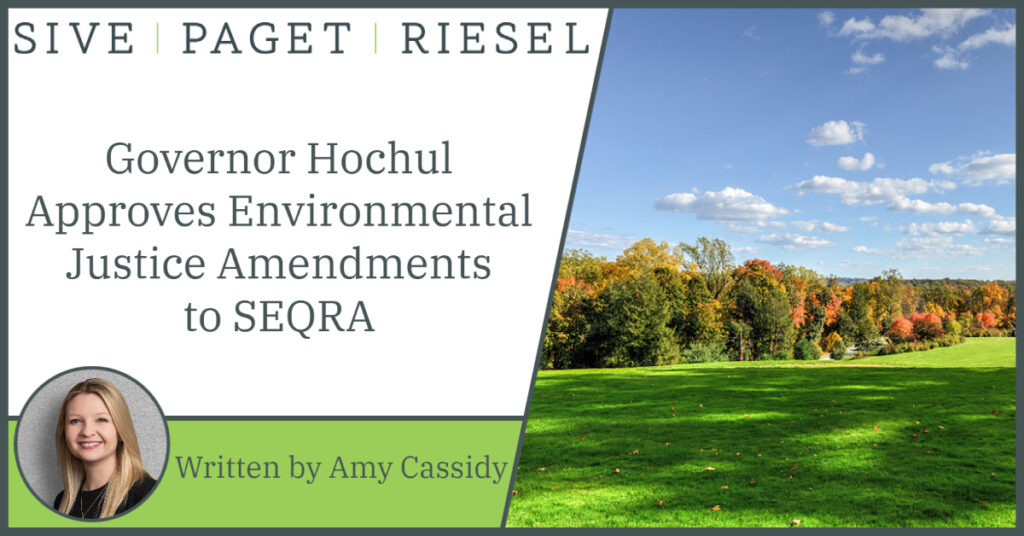Blog

Governor Hochul Approves Environmental Justice Amendments to SEQRA
On December 30, 2022, Governor Hochul approved a bill passed by the New York State Legislature (S8830/A2103-D), which incorporates environmental justice concerns into the State Environmental Quality Review Act (SEQRA) review process and the New York State Department of Environmental Conservation’s (NYSDEC) state permit approval process. Governor Hochul’s approval of the law is subject to the legislature making changes that have already been agreed to but have not yet been released (Approval Memorandum, No. 115).
As currently written, the law would amend the SEQRA review process in three important ways.
First, it adds additional criteria lead agencies must consider when determining whether an environmental impact statement (EIS) is needed for any proposed action that is not a “minor project,” as defined in the New York State Environmental Conservation Law (ECL) Section 70-0105 applying to NYSDEC permit programs. This requirement is sure to cause confusion for SEQRA lead agencies other than NYSDEC, because “minor project” is a definition contained in NYSDEC Uniform Procedures and is only used in NYSDEC permitting. “Minor project” is defined in the ECL as any action, which by its nature and with respect to its location, will not have a significant impact on the environment; NYSDEC has regulations set forth in 6 NYCRR § 621.4 that identify such projects based on size and type of activity. As currently written, it is unclear if projects that do not require a NYSDEC permit and which are not on the list of “minor projects” in 6 NYCRR § 621.4 can qualify for the “minor project” exemption from the new law.
For projects that do not fall squarely into the NYSDEC definition of “minor project,” SEQRA lead agencies will have to consider whether the project may “cause or increase a disproportionate [and/]or inequitable…burden on a disadvantaged community that is directly or significantly indirectly affected” by the project. The law uses the same definition of “disadvantaged community” as the Climate Leadership and Community Protection Act (CLCPA) and includes communities burdened by negative public health effects, environmental pollution, and climate change impacts, as well as communities that possess certain socioeconomic criteria or comprise high concentrations of low- and moderate-income households. An in-depth explanation of how “disadvantaged community” is defined in the CLCPA can be found in SPR’s prior blog post on this issue.
Second, the legislation requires NYSDEC to amend the SEQRA regulations to require lead agencies to consider “the extent to which a proposed action may reasonably be expected to cause or increase a disproportionate [and/]or inequitable…burden on disadvantaged communities” when determining whether a proposed action may have a significant effect on the environment. The law also requires NYSDEC to include on the list of “Type I” actions presumed to require an EIS “actions which may cause or increase, either directly or indirectly, a disproportionate [and]/or inequitable…pollution burden on a disadvantaged community.”
Third, where the lead agency has determined that an EIS is warranted, the EIS must include an analysis of the “effects of any proposed action on disadvantaged communities, including whether the action may cause or increase a disproportionate [and/]or inequitable…pollution burden on a disadvantaged community.”
The current version of the legislation also makes key changes to the NYSDEC permit approval process.
First, the law would require NYSDEC to prepare or cause to be prepared an “existing burden report” for non-minor projects “that may directly or indirectly affect a disadvantaged community.” While the form and content of the report will be set by NYSDEC regulations, the existing burden report must contain “baseline monitoring data” collected in the affected disadvantaged community within two years of the permit application or approval and must identify several types of information, including “each existing pollution source or categories of sources affecting a disadvantaged community,” the “ambient concentration of regulated air pollutants and regulated or unregulated toxic air pollutants,” and the project’s proximity to several types of infrastructure, including solid or hazardous waste management facilities, wastewater treatment plants, and hazardous waste sites.
NYSDEC will have to consider the “existing burden report” to determine if the project “may cause or contribute to, either directly or indirectly, a disproportionate [and/]or inequitable…pollution burden on a disadvantaged community.” If NYSDEC determines the project would have such an effect, it cannot approve or renew a permit for the project. Currently, there are no exceptions to this denial requirement in the law.
Although several sections of the law use the same or similar terms and standards, many of those terms and standards are not defined. For example, in its current form, the law does not define “disproportionate or inequitable burden” or “disproportionate or inequitable pollution burden.” It also does not define the standard for determining whether a disadvantaged community “may be directly or significantly indirectly affected” by a project or whether a project “may cause or increase, either directly or indirectly” a disproportionate or inequitable burden. The standard used to determine the effect of actions on disadvantaged communities also changes throughout the law, with some sections using “disproportionate or inequitable…burden” and other sections using “disproportionate or inequitable…pollution burden.”
Governor Hochul made her approval of the bill contingent on the adoption of legislative amendments, which have not yet been released. According to Governor Hochul, such amendments will be aimed at protecting disadvantaged communities from disproportionate pollution burdens while ensuring critical infrastructure, including affordable housing and renewable facilities, do not need to be removed (presumably because the law would apply to permit renewals as well as new facilities). The approval memorandum notes that the amendments “will also provide State and local governments sufficient time to update their current procedures and programs to implement this new law.”
The law would go into effect in late June of 2023.